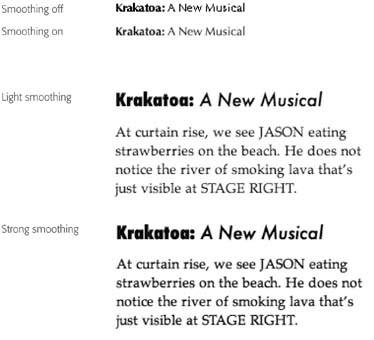Section 13.4. Appearance
This pane is mostly about how things look on the screen: windows , menus , buttons , scroll bars, and fonts. Nothing you find here lets you perform any radical surgery on the overall Mac OS X lookbut you can tweak certain settings to match your personal style.
13.4.1. Changing Colors
Two pop-up menus let you crank up or tone down Mac OS X's overall colorfulness:
-
Appearance . Choose between Blue or Graphite. Blue refers to Mac OS X's factory settingbright, candy -colored scroll-bar handles, progress bars,
 menu, and pulsing OK buttonsand those shiny red, yellow, and green buttons in the corner of every window. If you, like some graphics professionals, find all of this circus-poster coloring a bit distracting, then choose Graphite, which renders all of those interface elements in various shades of gray.
menu, and pulsing OK buttonsand those shiny red, yellow, and green buttons in the corner of every window. If you, like some graphics professionals, find all of this circus-poster coloring a bit distracting, then choose Graphite, which renders all of those interface elements in various shades of gray. -
Highlight color . When you drag your cursor across text, its background changes color to indicate that you've selected it. Exactly what color the background becomes is up to youjust choose the shade you want using this pop-up menu.
13.4.2. Tweaking the Scroll Bars
These radio buttons control the scroll-bar arrow buttons of all your windows. You can keep these arrows together at one end of the scroll bar, or you can split them up so that the "up" arrow sits at the top of the scroll bar, and the "down" arrow is at the bottoma much more Windows-like arrangement. (Horizontal scroll bars are similarly affected.)
Tip: For details on the "Jump to the next page" and "Scroll to here" options, see Section 1.11.8.
You can also turn on one or both of the following checkboxes:
-
Use smooth scrolling . This option makes pages lurch with slight accelerations when you click in the scroll bar, rather than with jerky scrolling motions .
-
Minimize when double clicking a window title bar . This option provides an extra way to minimize a window. In addition to the tiny yellow Minimize button at the upper-left corner of the window, you now have a much bigger targetthe entire title bar.
13.4.3. Number of Recent Items
Just how many of your recently opened documents and applications do you want the Mac to show using the Recent Items command in the ![]() menu? Pick a number from the pop-up menus. (You'll probably find that 5 is too few; 30 is more practical.)
menu? Pick a number from the pop-up menus. (You'll probably find that 5 is too few; 30 is more practical.)
13.4.4. Font Smoothing Style
The Mac's built in text-smoothing ( antialiasing ) feature is supposed to produce smoother, more commercial-looking text anywhere it appears on your Mac: in word processing documents, email messages, Web pages, and so on. Yet one of the most common complaints about Mac OS X is that it actually makes text look blurry to people who aren't used to the effect.
|
Fortunately, you can control the degree to which text gets smoothed. Use the pop-up menu to choose a setting that suits your eyesand your monitor. For example, Apple offers Standard for CRT screens ( cathode -ray tubethat is, traditional, bulky, television-style screens), and Medium for flat-panel screens like laptops and almost all current desktop Macs. Or just leave the setting at Automatic, to have Mac OS X use its best choice.
Either way, the differences are fairly subtle (see Figure 13-3). Furthermore, unlike most System Preferences, this one has no effect until the next time you open the program in question. In the Finder, for example, you won't notice the difference until you log out and log back in again.
13.4.5. Turning Off Smoothing on Tiny Fonts
At smaller type sizes (10-point and smaller), you might find that text is less readable with font smoothing turned on. It all depends upon the font, the size , and your taste. For that reason, this pop-up menu lets you choose a cutoff point for font smoothing. If you choose 12 here, for example, then 12-point (and smaller) type still appears crisp and sharp; only larger type, such as headlines, displays the graceful edge smoothing. You can choose a size cutoff as low as 4 points.
Note: None of these settings affects your printouts, only the onscreen display.
EAN: N/A
Pages: 371
